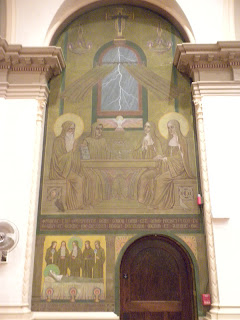Back in October, when we were undertaking our ambitious Open House Chicago itinerary, our second stop was right in our own backyard, practically within walking distance of our condo. It was a location that we had driven past dozens and dozens of times, and yet, we had no idea what it was.
In fact, I had always assumed the structure was a school, based on the signage. As it turned out, the building is a Benedictine convent, home to a community of nuns, who just happen to worship at a lovely and historic chapel inside the compound. If it hadn't been for Open House Chicago, I never would have given this building a second thought, and I certainly never would have had the opportunity to view the beauty that lies within.
St. Scholastica
7430 North Ridge Boulevard
Chicago, IL
The Benedictine order opened their Roger's Park facility in 1907, dedicating it to Saint Scholastica, the sister of Saint Benedict, founder of their order, and the patron saint of nuns. Their current chapel, however, came into existence with the construction of a major addition to the building in 1924. To this day, the sisters observe their morning prayers, vespers, and Sunday masses there.
Architecturally, the chapel is rather plain; instead, it is the striking murals that define the space. They were painted in 1938, when the order paid to bring Josef Steinhage, a German painter who had trained in ecclesiastic art, to the United States to work on the project. Though the murals reminded me of Byzantine art, due to the bold outlines, prominent use of gold, and the faux-mosaic work painted into the backgrounds, I learned that they are actually considered to be Beuronese in style.
The Beuronese school of art is unique to the Benedictine order, and was developed by monks living in Germany. Its works are notable for their subdued color palette (so as not to distract worshipers from thoughts of God), early Christian influences (hence my connection to Byzantine art), and its integration with architecture. Before visiting St. Scholastica, I had certainly never heard of this obscure school of religious art, but I was glad to have had the opportunity to see an example of it with my own eyes, and to expand my base of knowledge.
The main altar depicts a relatively generic scene of Jesus, the four evangelists, and eight saints with particular significance to the Benedictine order. Because Christ is the center and focus of worship, the brightest colors are reserved for the panels depicting him and his stories. Flanking the altar are two scenes of Christ's miracles.
Off to the side of the chapel is a scene in more muted colors depicting a major story from the life of Saints Scholastica and Benedict. Apparently, since the two siblings had both taken holy orders, they were only permitted to meet once a year, during which they would discuss matters of faith. Near the end of Scholastica's life, she sensed that this meeting would be their last, and when her brother was preparing to leave, she prayed for a terrible storm that would prevent him from going so that they could talk a bit longer. God answered her prayers by initiating a violent storm, and Scholastica died shortly thereafter.
Today, the murals remain in an incredible state of preservation, largely due to a 1993 restoration by two students from the Art Institute of Chicago, whom the nuns persuaded to take on the project for free, as a senior thesis. When they first laid eyes on the chapel, they were overwhelmed by the prospect of having to match all of the original paint colors, and feared that the project would be impossible on the non-existent budget.
One of the elderly sisters came to the rescue, remembering that one of the nuns at St. Scholastica in the 1930s had been of an especially thrifty mindset. Rather than throw away Steinhage's leftover paint, she had painstakingly saved all of the extra paint cans and soldered them shut. Fifty-five years later, their contents were still good, and the students were able to use it to complete the restoration. It almost seems like a miracle in its own right.
The chapel is also notable for its stained glass, not because they were completed by a famous workshop, but because they were designed by one of the sisters. I doubt that many places of worship can boast such an intimate connection between its artwork and its parishioners.





No comments:
Post a Comment